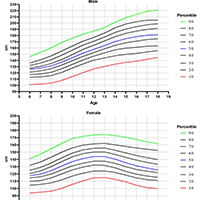Percentile values of the standing broad jump in children and adolescence aged 6-18 years old
The standing broad jump (SBJ) is a valid, reliable and feasible field-based test, which can evaluate explosive strength of the lower limbs and physical fitness. This study aimed to provide normative data for the SBJ for male and female children and adolescents and describe differences in performance between age groups and genders. A total number of 2140 children and adolescents, sampled in seven European nations have been included for analysis. The SBJ was performed to derive percentile values for gender and each age group. In general, males have greater jumping performance compared to females. Data demonstrate a linear increase in the jumping distance for both males and females until adolescence. However, such increase is evident in males up to 16-17 years old, whereas in females a plateau value is met at 12-13 years old, with a subsequent decrease in the jumping performance. No differences were present in jumping performance between male and female children, however differences between male and female adolescents were evinced. The study has provided percentile values useful to monitor the physical fitness status of children and adolescents.
How to Cite
PAGEPress has chosen to apply the Creative Commons Attribution NonCommercial 4.0 International License (CC BY-NC 4.0) to all manuscripts to be published.

 https://doi.org/10.4081/ejtm.2020.9050
https://doi.org/10.4081/ejtm.2020.9050




